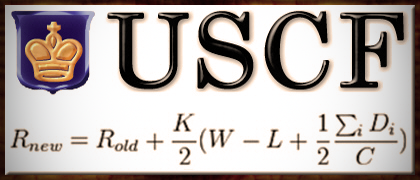|

“The USCF was incorporated in Illinois on December 27, 1939”
A Chess rating system is a system used in
Chess to calculate an estimate of the strength of the player, based on his or her performance versus other players.
It is used by organizations such as FIDE, the US Chess Federation (USCF), International Correspondence Chess Federation, and the English Chess Federation.

Most of the systems are used to recalculate ratings after a tournament or match but some are
also used to recalculate ratings after individual games.
In almost all systems a higher number indicates a stronger player.
In general, players' ratings go up if they perform better than expected and down if they perform worse than expected.
The magnitude of the change depends on the rating of their opponents. The Elo rating system is currently the most widely used.
The United States Chess Federation (USCF) categorizes players by rating:
Class E, Class D, Class C, Class B, Class A.
Expert Master, Senior Master.
Category Rating range:
Grandmaster 2600 +
Senior master 2400–2599
Master 2200–2399
Expert 2000–2199
Class A 1800–1999
Class B 1600–1799
Class C under 1600
These performance norms are achieved in twenty four (24) games or more within a three year period.
An A-player has a rating between 1800 and 1999 and is among the top 17% of all tournament players.
Numerical ratings are estimates of Chess skill based on tournament results.
Rating points are awarded or subtracted for winning or losing games in recognized tournaments.
More points are gained for beating stronger opponents or lost for losing to weaker ones.
|